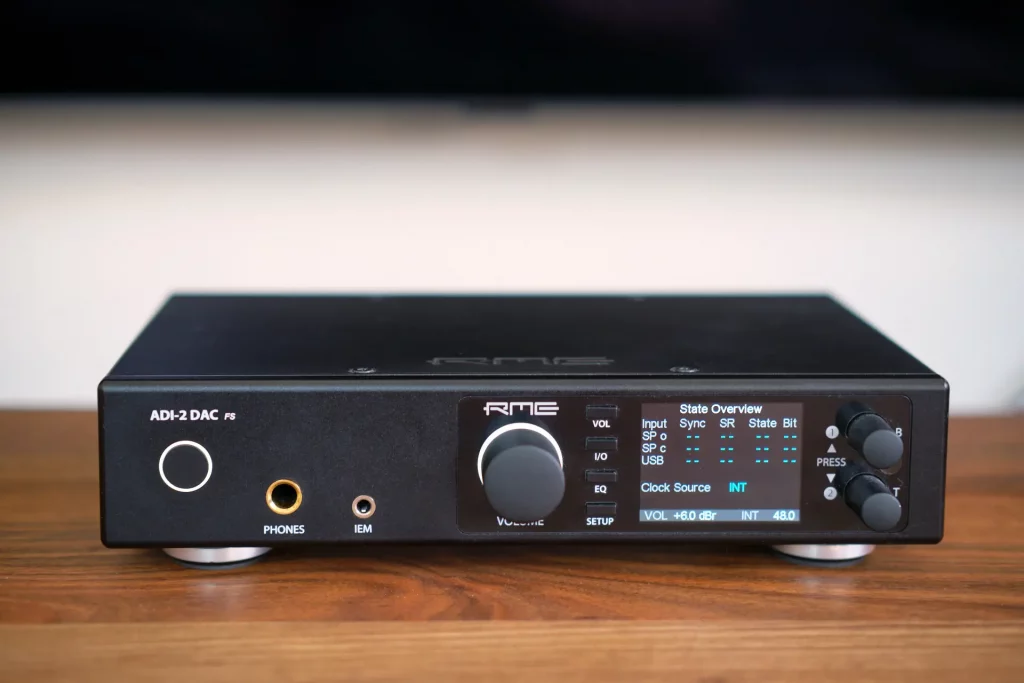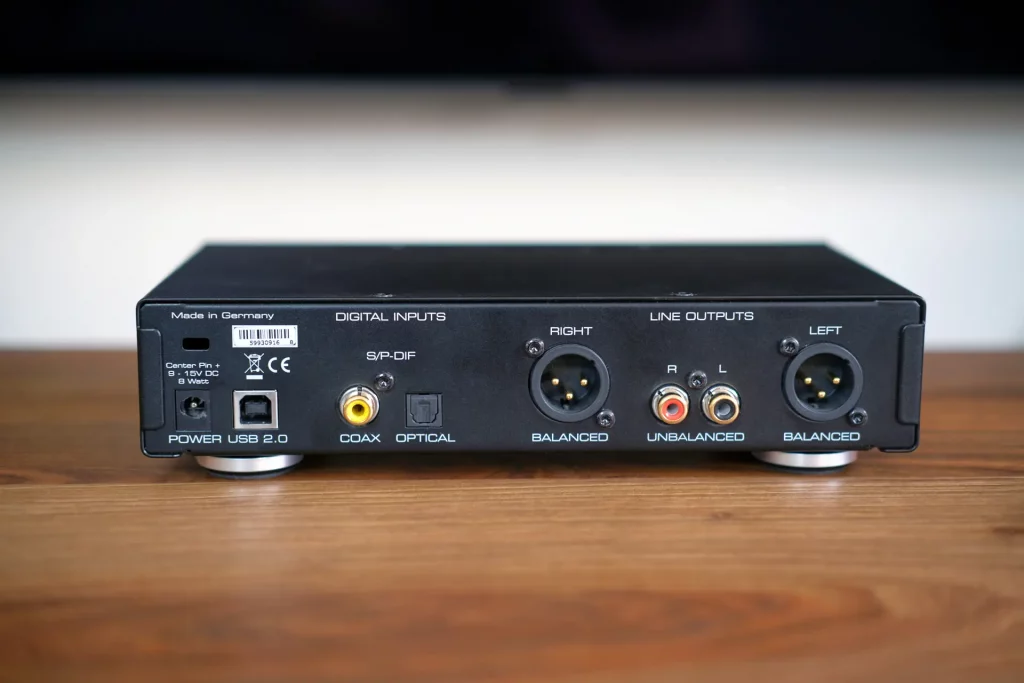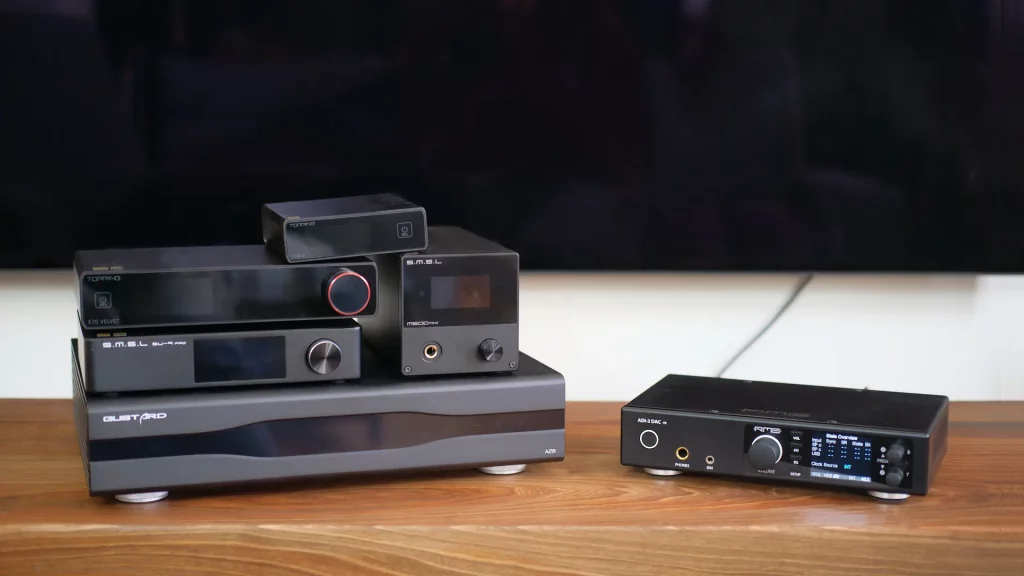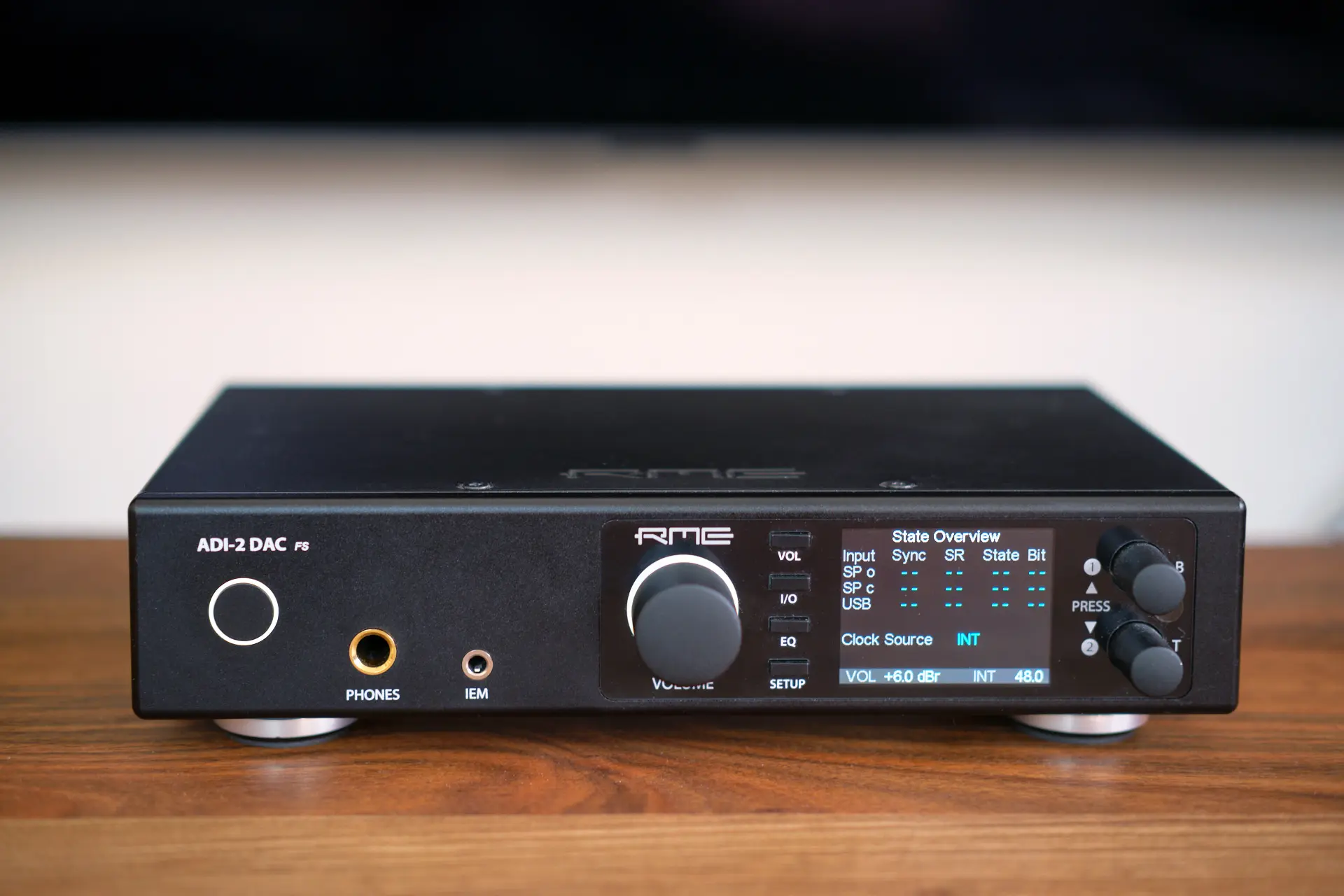RME ADI-2 FS has been around for several years now and it’s widely regarded as the golden standard for a neutral sounding DAC. Thanks to a friend Sloba who loaned it to me, I was able to put it to the test and many comparisons to find out how it stacks against the more recent competition. So let’s start.
RME ADI-2 FS versions
An important thing to mention is that I had an older version of ADI-2 FS with an AKM AK4493 DAC chip. Since troubles at the AKM factory, RME silently switched to the ES9028Q2M chip from ESS without changing the model name. It is said that they sound remarkably the same but I can not confirm or deny that since I only had the AKM version.
Build and Features
RME ADI-2 FS is a nicely built unit. Metal sheets were used for the casing, it’s sturdy and functional but doesn’t have that premium feel that thicker aluminum often brings. The whole design feels practical and functional first and foremost, with bling not being high on the priority list. This might have something to do with RME being a German brand and coming from the professional market too. There’s nothing wrong about that, it actually feels quite wholesome.
Since ADI-2 FS is not a new model, I won’t get into details and every single feature it has. I’ll just quickly mention that it has fantastic measured performance, inbuilt EQ features, and headphone output, and the second one is dedicated to sensitive IEMs with a decreased noise floor. Volume attenuation has a smart way of combining several different output levels with digital attenuation… so digital attenuation never has to go very deep and start losing dynamic range. This makes ADI-2 FS better suited to be used as a preamp than your average DAC.
The front panel contains a small screen and several knobs that are helpful for using any of its many features. A remote control is included too.


In the back, we can see usual digital inputs in the form of USB, and coaxial and optical SPDIF. If you’re wondering about the maximum bitrate and sample rate, please take a look at the spec sheet at the end of this page. I’ll just say that ADI-2 FS won’t leave you wanting for anything regarding Hi-Res support.
On the output side, there are a pair of single-ended RCAs and balanced XLRs. Both sets of outputs are variable in level. The whole device is powered by the DC, meaning it uses an external power brick. This also leaves a room for potential power supply upgrade, but given the limited time I had with this DAC, I didn’t venture into that and I’ve done all my tests with a factory power supply.
Test
I listened to the RME ADI-2 FS in my main setup which at the time consisted of these components:
- Audio Streamer: Pi2Design Mercury (fed by Allo Shanti LPS)
- DACs: Gustard R26, A26, SMSL SU-10, Topping E70
- Preamplifier: Acoustic Invader Fulcrum
- Power Amplifier: Acoustic Invader Amp (with IcePower 1200AS2)
- Speakers: Spirit Wind by Jeff Bagby, KEF LS50
- Headphones: Goldplanar GL2000, Verum 1, AKG K702, Hifiman HE4xx
I tested it both as a DAC only where volume control was delegated to my preamp, and connected directly to my power amp where volume attenuation was delegated to the RME ADI-2 FS DAC itself. So let’s start with the DAC section.
Sound (as a DAC, fixed line output)
For some reason, I expected this DAC to sound flat and too bright, this is luckily not the case. Instead, it sounds very neutral, even having a healthy dose of fullness and lushness to its sound. The bassline, midbass included, is deep and pleasantly warm. This lends a slight warmth and richness to the midrange which is nothing close to the colder and analytical signature I expected. But if you think that RME sacrificed detail retrieval for it, you’re wrong. ADI-2 FS is a very transparent and detail-rich sounding DAC, especially in the midrange region. This goes for clean edges and transient, but also for the rich inner-tone texture. Both male and female vocals sound present and realistic. One of my favorite vocals of all time – Norah Jones – sounds very husky and sandy, but also full-bodied and never sibilant – great. Highs are well-extended but avoid any sort of hardness or harshness too. There’s nothing to complain about this DAC’s tonality really, it’s a skillful balance between gentle warmth and great transparency that provides a very revealing, yet very natural and pleasant sound signature.
RME ADI-2 spreads and layers all tones in a respectably wide and airy soundstage. That said, the soundstage depth is lacking compared with many capable DACs on the market, but more on that in the comparison section. Generally speaking, its soundstaging skill would be very good for a DAC costing half the price, but at its actual price, one might expect more space in all dimensions nowadays.
Dynamics are good and ADI-2 FS sounds alive and engaging. It has enough speed to follow the fast rhythm if needed but it will never sound relentless, analytical, or mechanically precise.
Sound (as a Preamp, variable output)
As already mentioned, RME ADI-2 FS has a smart way of handling its variable output. It enables higher output voltages at higher listening levels, and it uses digital attenuation until it reaches a low enough volume to step down to a lower output voltage level. At this point, the hardware switches to a lower level, and the digital attenuation is reset to zero. ADI-2 FS can do four different output levels in its hardware, filling much shorter in-between intervals with a gradual digital attenuation. I can’t say for sure if this is the reason, but this DAC performed very well in the role of a small preamp connected directly to the power amp. All of its previously mentioned sound qualities were preserved. Adding any price-appropriate preamplifier instead didn’t do anything but bring its own coloration to the mix. It took something like my own Acoustic Invader preamp to make those changes pleasant and desirable by adding more slam and more air up top.
To put it simply, I found this DAC to perform better as a preamp than I came to expect from an average model that is more often than not just passable in this role. That’s why I usually don’t include this section in my reviews but I’ve decided to put it in this one.
Sound (Headphone output)
Once again, RME ADI-2 FS shows to be a well-balanced product across the board. Everything I said for its sound signature in the DAC section stands here too. Its power delivery is decent and will be suitable for most headphones on the market. It managed to drive all of my headphones of various impedances and sensitivities well. This included very low-impedance planner magnetic models such as Verum 1 with its 8 Ohms. Even in this situation I never observed any background hiss or noise. Another feature to notice is that RME includes a crossfeed option that some listeners prefer having while listening to headphones. A very capable Head-Fi component indeed.

Comparisons
Topping E70 velvet is a DAC with volume control but without headphone output. It comes at less than half the price of ADI-2 FS and it’s built around a newer and more advanced AKM DAC chip. That said, the end result when it comes to the sound fidelity is not on pair. While the overall tonality of these two DACs is equally neutral and very comparable, there’s a noticeable difference in clarity. RME ADI-2 FS simply resolves more fine details, making E70 velvet sounding just a touch veiled in comparison. This kind of difference is not night and day, and E70 velvet is much closer performance-wise than the price difference suggests. However, add more EQ functions, and a very decent headphone output on top, and it starts to become clear why you might prefer ADI-2 FS.
SMSL SU-9 pro is very comparable to E70 velvet in terms of features, resolution, and detail retrieval. I won’t take much time here because the conclusion is the same as it was in a previous passage.
SMSL SU-10 once again has a feature set that’s in line with SU-9 pro and E70 velvet, but it comes with a higher price tag and performance to match it. SU-10 sounds a bit warmer and softer. RME ADI-2 FS is more precise and can digg a bit more information from the recording, but doesn’t sound as full and lush as SMSL. The SU-10 is capable of creating a slightly wider soundstage too, adding to the picture of a bigger and simply more relaxed sound. In this case, I can’t claim an absolute winner. Personal preference and system matching will play a big role in which one you would prefer.
Gustard A26 is yet another AKM-based model but at a slightly higher price this time. It once again doesn’t offer a headphone output but includes a LAN input and can be used as a music renderer connected directly to your network. These features aside, A26 sounds more resolving, and more dynamic, creating a wider and taller soundstage with more air around tones. To cut it short, A26 is simply a better performer. As a cherry on top, this one features a more premium build too. So if EQ and headphone output are not needed, Gustard A26 takes an easy win here.
Gustard R26 shares the same set of features and build quality as A26 but it’s an R2R design this time. It can’t match the sheer detail retrieval of A26 but it’s on pair with ADI-2 FS in that regard. R26 sounds tonally fuller than RME with more bass slam, more body, and a richer tone timbre. It also creates a noticeably bigger soundstage, with much more prominent depth perception. Simply put, R26 sounds bigger, fuller, and more three-dimensional. RME ADI-2 FS will present you with an equal amount of details but in a smaller and much flatter space.
Comparison (headphone out)
I’ll do only one comparison here. I found Topping’s E70v/L70 stack to be fully comparable soundwise to RME ADI-2 FS. Tonality, detail retrieval, and soundstaging. All of that was so comparable that I often couldn’t differentiate them apart. Given that ADI-2 FS clearly outperformed E70 velvet as a DAC only in my room setup, it suggests that headphone output is not letting all of the DAC’s capabilities through. So in terms of sheer sound fidelity, Topping’s stack presents a better value for exclusive headphone users. On the other hand, ADI-2 does offer EQ and crossfeed that can come in handy.
Conclusion
RME ADI-2 FS does many things and it does them very well too. If you single out any of them, you can for sure find a better-performing device that does only that function. On the other hand, if you simply want one multipurpose device that is consistent across the board and makes for a more than capable DAC, headphone amp, simple preamp, and offers some convenient EQ functionalities – it’s hard to find an equally appealing product. It’s clear to me that RME ADI-2 FS didn’t become very popular for no reason and it’s still a very strong competitor in 2023.
| RME ADI-2 FS – CHARACTERISTICS |
|
Sample rates: 44.1 kHz up to 768 kHz
1x S/PDIF input coaxial
|







Hey,
Great comparison, thank you!
Have you by chance tested the SMSL DO400? How do you think it would compare to the RME?
I’m looking for a amp/dac aio or stack to connect to my PC with HD6XX headphones.
Which one is better do you think? I can EQ on the PC if needed.
I think that rme is not poular because it demand quite high quality hi-fi system to uncover all his capabilities. for example I’m listening it on speakers and amplifier which are each one 3 times the price of that dac
Bonsoir, j’ai testé le SMSL DO400 contre le RME ADI 2 DAC et très franchement le combat n’a pas duré longtemps. J’ai remi le SMSL dans le carton au bout d’une heure de comparaison. Au délo de son aspect et écran cheap, le SMSL sonnait moins détaillé et pas plus musicale pour autant. Il n’est clairement au niveau d’un RME ADI 2 DAC.
I’ve had this RME model for a couple years now, and at my young age of 50 I’ve had a number of Dac’s in the past. My opinion would be if you are wanting to build a digital or streaming system the RME is a great piece to start with. You can use it as a preamp..which it is an outstanding as a pre. The RME can push any amplifier out there on the market. I use the XLR output to power amp, RCA output to subwoofer. The PEQ functions allow me to EQ my speakers to a better in-room Frequency Response..I use REW & Umik-1 for measurements. Variable frequency Loudness Button. It has more options but I named just a few of the ones I use.
Best part of the Dac is that it sounds great. 20bits of Dynamic music if the rest of your gear can match it. I’ve also used the RME with Tube preamps and I like that with the RME you can adjust the output voltage to be a perfect match for whatever preamp you choose. One of my favorite pieces of audio gear I’ve ever purchased, but definitely not the most expensive.
I enjoy your youtube reviews. They are thoughtful and extremely articulate. Thank you.
I have been seeking a decent headphone amp and it is now down to a choice between the RME, the Violectric 202 and the Icon Audio HP8. Sadly, these are sufficiently left field that comparative auditioning is not easily done if you live in the south of England. So reviews and forums are very important.
Having done some legwork (finger work?) I am leaning towards the RME for several reasons, in no particular order
1. It is small (but so is the Violectric) and transportable, useful particularly for its DAC
2. It is much more than a pure headphone amp and the preamp and DAC capabilities offer a lot of additional potential
3. I have long experience with RME and their units are rock solid, both in build and in stability
4. It has parametric EQ and the relevant EQ characteristics of different headphones can easily be dialled in
5. It has an IR remote controller which is very fully featured
6. There is now a remote pc / mac / ios app which simplifies greatly the complex hardware controls.
This sort of flexibility offers a huge uplift in value on the Violectric, while the HP8 might be a bit of an indulgence.
The only downside is the lack of analog inputs and ADC but you can’t have everything!
Great review and I completely agree with your findings. I have had RME ADI-2DAC FS for over a year. Great DAC but after a while and some other DACs comparisons I found that the soundstage is rather flat, shallow and forward. After some more analysis and reviews it became clear that the AMP section can’t drive max performance from more difficult low sensitivity/ impedance headphones like exp: Dan Clark Aeon2 Noire. I decided to buy higher level headphones AMP – Ferrum OOR. So, my chain is Qobuz stream to PC – > USB -> ADI-2 DAC /preamp (XLR) -> OOR (in pass through mode) (4 pin XLR) -> DC Noire or HIFIMAn Edition XS or ARYA Organic. The result is fantastic. Possibly, other AMP (Topping, SMSL) may also do the trick. Summary : excellent DAC/preamp, outstanding DSP, so so AMP.